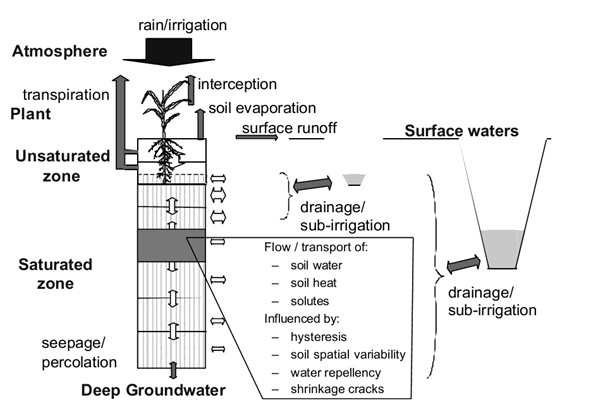Performance of ISIAMOD and SWAP models in estimating Soil water balance components of a maize crop (Sammaz-28) under Rain-Fed condition
DOI:
https://doi.org/10.57056/ajet.v9i2.183Keywords:
Simulation model, Soil Water Balance, Water management, ISIAMODAbstract
In this paper, the performance of Irrigation Scheduling Impact Assessment model (ISIAMOD) and Soil-Water-Atmosphere-Plant (SWAP) relationship model in estimating soil water balance of a cropped field under rainfall condition was studied under a sandy clayed loamy soil at the research field of the department of Agricultural Engineering, Ahmadu Bello University, Samaru, Zaria-Nigeria. Soil water balance data from the field study were used as reference values for the models performance evaluations. The statistical indicators used to compare the performance of the models were coefficient of residual mass (CRM), modelling efficiency (EF) and root mean square error (RMSE). The results showed that the two models satisfactorily simulated soil water balance components as their output compared closely to field measured data. CRM showed that ISIAMOD has the tendency of underestimating the ET, T, and Ecrop by a value which ranges from 2.5 to 6.0 % while SWAP has the tendency of overestimating the same components which ranges from 2.0 to 9 %. The modeling efficiencies of the two models range from 84 to 90 %, except for evaporation processes which ranges from 54 to 62 %. The RMSE of the two models ranges from 0.29 to 0.86. They both simulated the seasonal run-off and drainage well. The results show that the two models can be used for determination of soil water balance components of cropped soil and for analyzing a better water management option for agricultural production.
References
Belman C, Wesseling JG, Feddes RA. Simulation of the water of a cropped soil: SWATRE. J Hydrol. 1983;63:271–86.
Qureshi SA, Madramootoo CA. Modeling the soil water balance of a sugarcane crop in Sindh, Pakistan, with SWAP93. Can Water Resour J. 2001;26(1).
24. Zhang Y, Yu Q, Liu C, Jiang J, Zhang X. Estimation of winter wheat evapotranspiration under water stress with a semi-empirical approach. Agron J. 2004;96:159–68
Igbadun HE. Effect of deficit irrigation scheduling on yield and soil water balance of irrigated maize. Irrig Sci. 2008;27:11–23.
Igbadun HE. Irrigation scheduling impact assessment model (ISIAMOD): A decision tool for irrigation scheduling. Indian J Sci Technol. 2012;5(8).
Igbadun HE. Evaluation of irrigation scheduling strategies for improving water productivity: Computer-based simulation model approach [PhD thesis]. Morogoro, Tanzania: Sokoine University of Agriculture; 2006.
Ines AVM, Droogers P, Makin IWM, Das Gupta A. Crop growth and soil water balance modeling to explore water management options. IWMI Working Paper 22. Colombo, Sri Lanka: International Water Management Institute; 2001.
Cavero J, Inme F, Philippe D, Jose MF. Simulation of maize yield under water stress with EPICphase and CROPWAT models. Agron J. 2000;92:679–90.
Glavan M, Pintar M. Strengths, weaknesses, opportunities, and threats of catchment modelling with soil and water assessment tool (SWAT) model. In: Water Resources Management and Modeling. Rijeka, Croatia: InTech Open; 2015.
Kroes JG, Van Dam JC. Reference manual of SWAP version 3.03. Alterra-Report; 2003.
Ogunwole JO, Babalola OA, Oyinlola EY, Raji BA. A pedological characterization of soils in the Samaru area of Nigeria. Samaru J Agric Res. 2001;17:71–7.
Van Genuchten MT. A closed-form equation for predicting the hydraulic conductivity of unsaturated soil. Soil Sci Soc Am J. 1980;44:892–8.
Mualem Y. A new model for predicting the hydraulic conductivity of unsaturated porous media. Water Resour Res. 1976;12:513–23.
Van Dam JC. Field-scale water flow and solute transport. SWAP model concepts, parameter estimation, and case studies [PhD thesis]. Wageningen, the Netherlands: Wageningen University; 2000.
Ogunwole JO, Babalola OA, Oyinlola EY, Raji BA. A pedological characterization of soils in the Samaru area of Nigeria. Samaru J Agric Res. 2001;17:71–7.
FAO-UNESCO. Soil Map of the World. Revised Legend. Tech paper No.20. FAO/Rome and ISRIC/Wageningen, the Netherlands; 1994.
Mahdian MH, Gallichard J. Validation of the SUBSTOR model for simulating soil water content. Trans Am Soc Agric Eng. 1995;38:513–20.
Ma Y, Feng S, Huo Z, Song X. Application of the SWAP model to simulate the field water cycle under deficit irrigation in Beijing, China. China. Math Comput Model. 2011 Aug 1;54(3-4):1044-52.
Igbadun HE, Mahoo HF, Tarimo AKPR, Salim BA. Simulation of soil moisture dynamics of the soil profile of a maize crop under deficit irrigation scheduling. Agric Eng Int. 2007;IX:LW 06 015.
Giuseppina C, Francesco M, Domenico V. Application of the SWAP model to predict impact of climate change on soil water balance in a Sicilian vineyard. Ital J Agron. 2012;7:e17.
Nasonova ON, Gusev EM, Kovalev EE. Climate change impact on water balance components in Arctic river basins. Geogr Environ Sustain. 2022;4(15):148–57. https://doi.org/10.24057/2071-9388-2021-144.
Quirijn JL, Marina LA, Everton ARP. Stochastic analysis of plant available water estimates and soil water balance components simulated by a hydrological model. Vadose Zone J. 2023;23:e20306. https://doi.org/10.1002/vzj2.20306.
Xiaowen W, Huanjie C, Liang L, Xiaoyun W. Estimating soil water content and evapotranspiration of winter wheat under deficit irrigation based on SWAP model. Sustainability. 2020;12:9451. https://doi.org/10.3390/su12229451.

Downloads
Published
How to Cite
Issue
Section
License
Copyright (c) 2024 Aliyu Salisu Ibrahim, Henry Evonameh Igbadun, Omafuvwe Joseph Mudiare

This work is licensed under a Creative Commons Attribution-NonCommercial 4.0 International License.





